Comprehensive Analysis of DMACK's Organisational Strategy
VerifiedAdded on 2020/12/10
|9
|2957
|286
Report
AI Summary
This report provides a comprehensive analysis of DMACK's organizational strategy. It begins with an introduction to organizational strategy and then delves into a detailed examination of DMACK, a UK-based motor-sport tyre manufacturer. The main body of the report covers macro-environmental factors using PESTEL analysis, assessing political, economic, social, technological, environmental, and legal influences. It then evaluates DMACK's industry position using Porter's Five Forces model, analyzing competitive rivalry, supplier power, buyer power, threats of substitution, and threats of new entry. The report also scrutinizes DMACK's internal resources and capabilities through the VRIO framework, assessing value, rarity, imitability, and organization. Finally, it explores stakeholder perspectives, including those of investors, customers, and employees, to provide a holistic view of the company's strategic landscape. The report concludes with a summary of findings and a discussion of the implications for DMACK's future strategic direction.
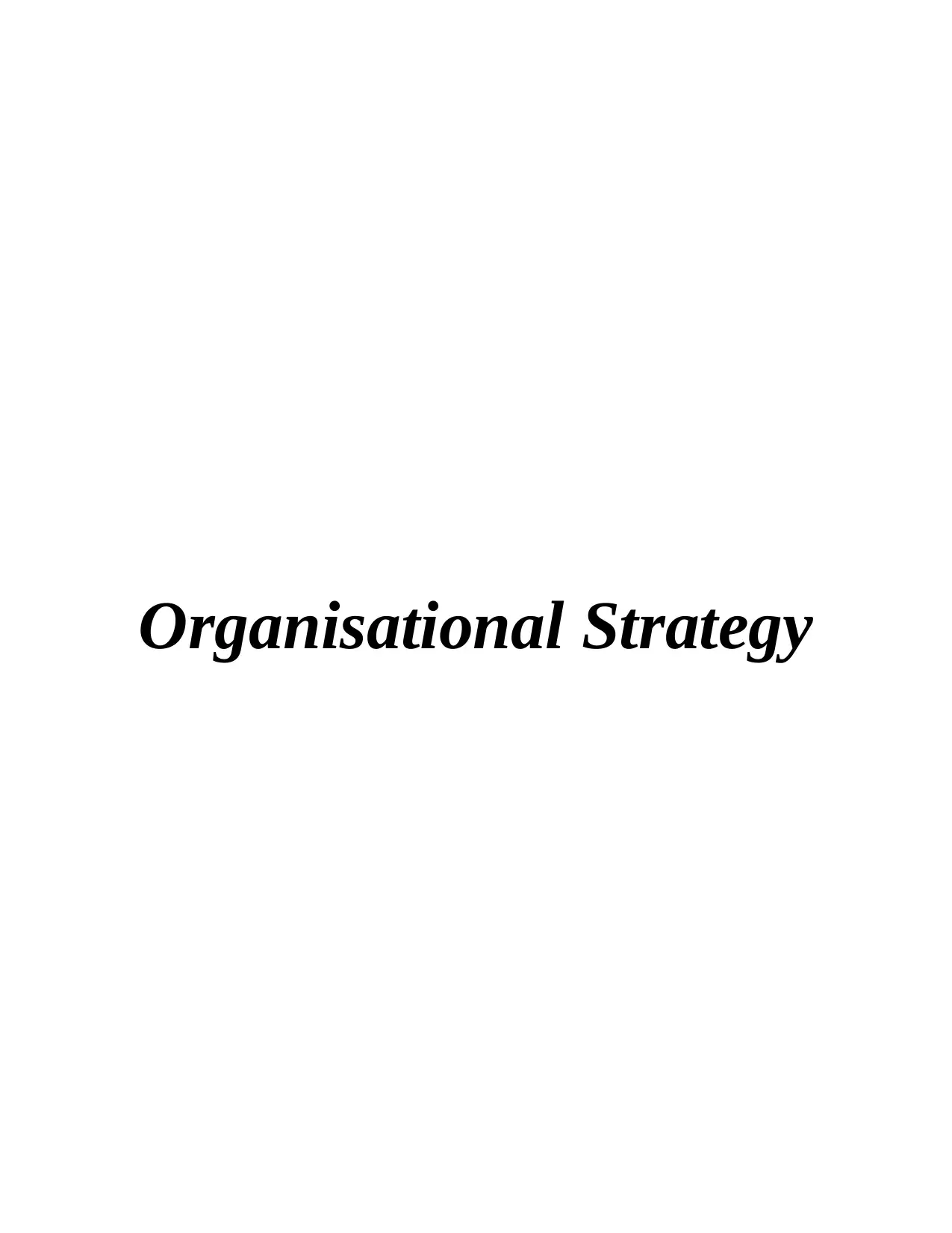
Organisational Strategy
Paraphrase This Document
Need a fresh take? Get an instant paraphrase of this document with our AI Paraphraser
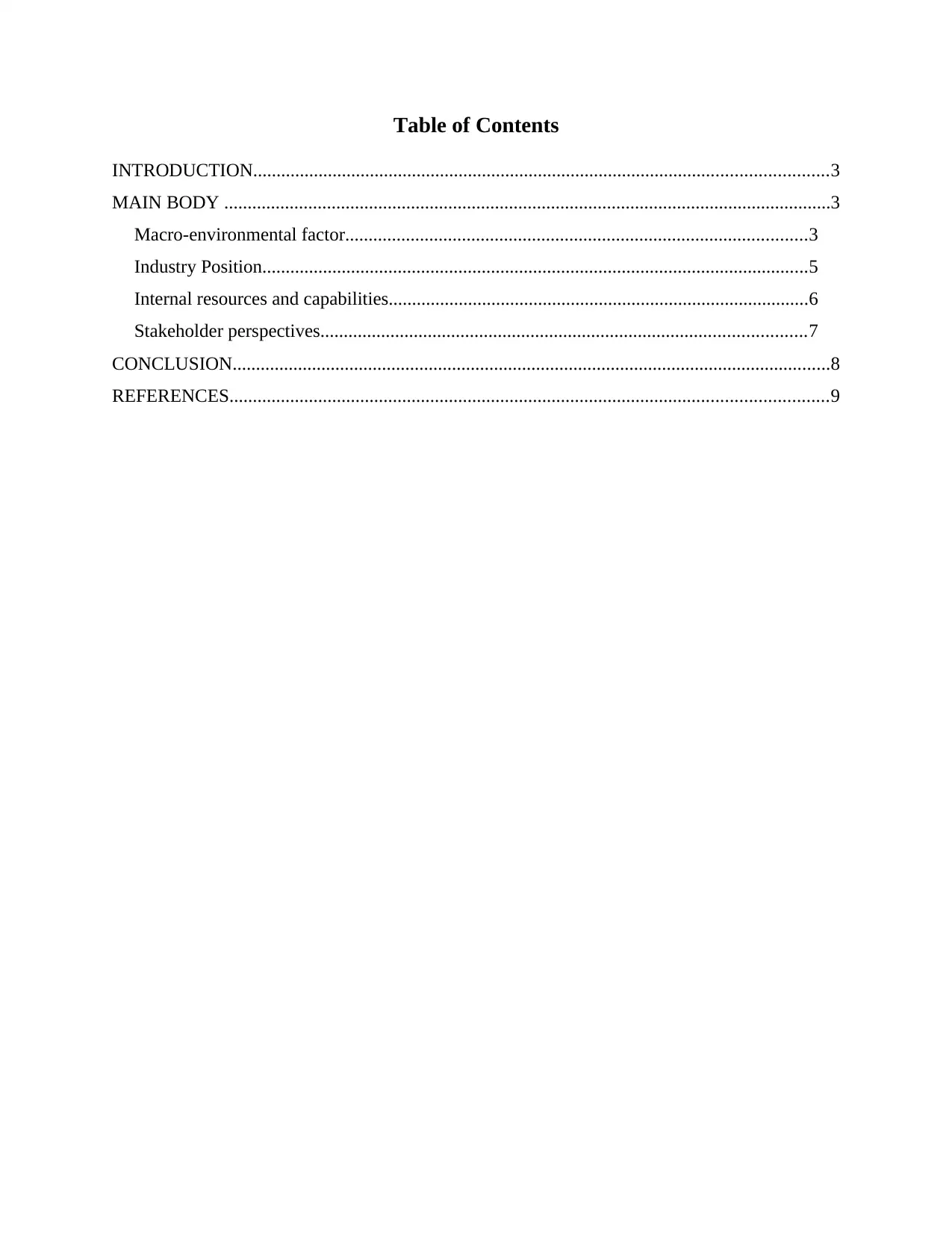
Table of Contents
INTRODUCTION...........................................................................................................................3
MAIN BODY ..................................................................................................................................3
Macro-environmental factor...................................................................................................3
Industry Position.....................................................................................................................5
Internal resources and capabilities..........................................................................................6
Stakeholder perspectives........................................................................................................7
CONCLUSION................................................................................................................................8
REFERENCES................................................................................................................................9
INTRODUCTION...........................................................................................................................3
MAIN BODY ..................................................................................................................................3
Macro-environmental factor...................................................................................................3
Industry Position.....................................................................................................................5
Internal resources and capabilities..........................................................................................6
Stakeholder perspectives........................................................................................................7
CONCLUSION................................................................................................................................8
REFERENCES................................................................................................................................9
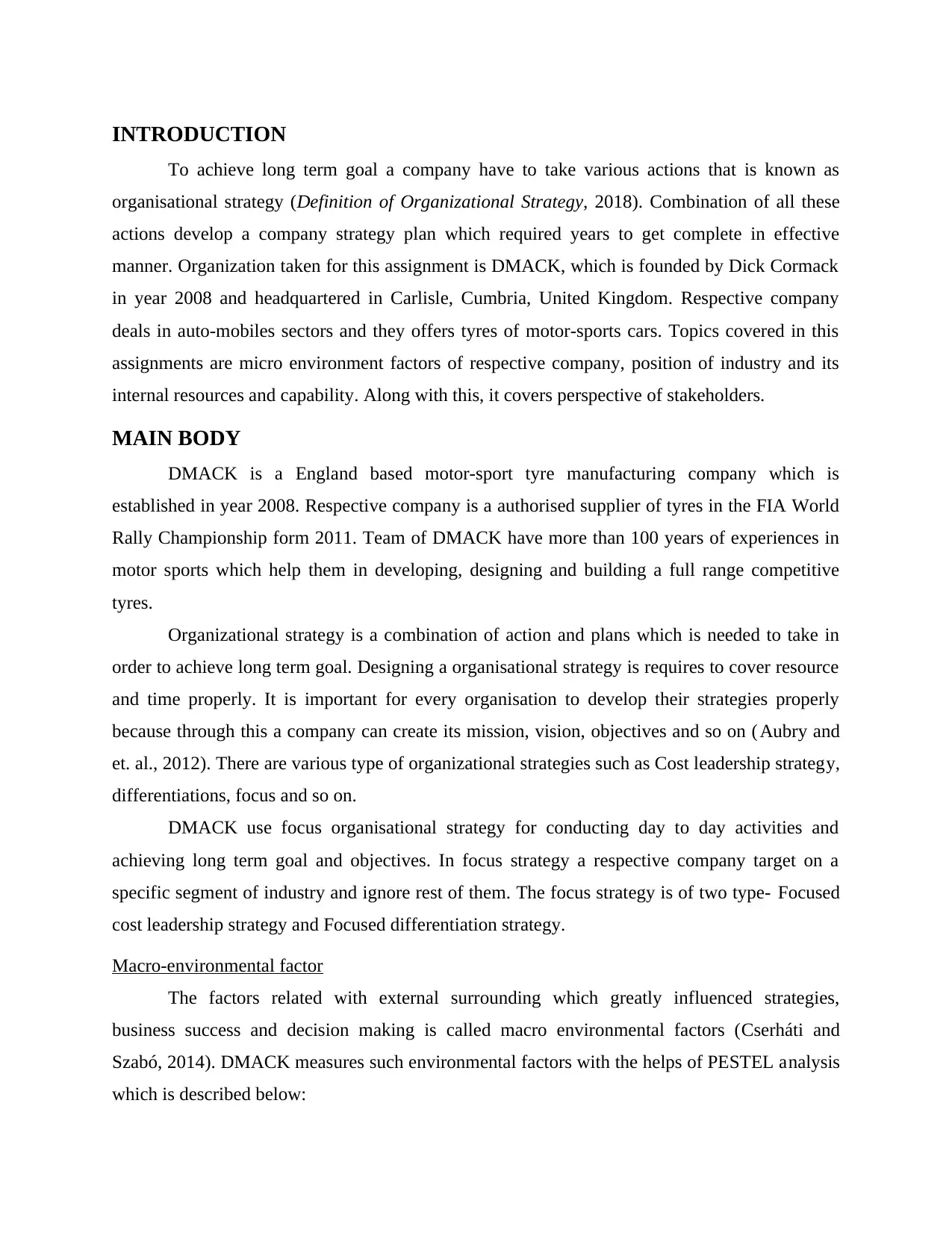
INTRODUCTION
To achieve long term goal a company have to take various actions that is known as
organisational strategy (Definition of Organizational Strategy, 2018). Combination of all these
actions develop a company strategy plan which required years to get complete in effective
manner. Organization taken for this assignment is DMACK, which is founded by Dick Cormack
in year 2008 and headquartered in Carlisle, Cumbria, United Kingdom. Respective company
deals in auto-mobiles sectors and they offers tyres of motor-sports cars. Topics covered in this
assignments are micro environment factors of respective company, position of industry and its
internal resources and capability. Along with this, it covers perspective of stakeholders.
MAIN BODY
DMACK is a England based motor-sport tyre manufacturing company which is
established in year 2008. Respective company is a authorised supplier of tyres in the FIA World
Rally Championship form 2011. Team of DMACK have more than 100 years of experiences in
motor sports which help them in developing, designing and building a full range competitive
tyres.
Organizational strategy is a combination of action and plans which is needed to take in
order to achieve long term goal. Designing a organisational strategy is requires to cover resource
and time properly. It is important for every organisation to develop their strategies properly
because through this a company can create its mission, vision, objectives and so on (Aubry and
et. al., 2012). There are various type of organizational strategies such as Cost leadership strategy,
differentiations, focus and so on.
DMACK use focus organisational strategy for conducting day to day activities and
achieving long term goal and objectives. In focus strategy a respective company target on a
specific segment of industry and ignore rest of them. The focus strategy is of two type- Focused
cost leadership strategy and Focused differentiation strategy.
Macro-environmental factor
The factors related with external surrounding which greatly influenced strategies,
business success and decision making is called macro environmental factors (Cserháti and
Szabó, 2014). DMACK measures such environmental factors with the helps of PESTEL analysis
which is described below:
To achieve long term goal a company have to take various actions that is known as
organisational strategy (Definition of Organizational Strategy, 2018). Combination of all these
actions develop a company strategy plan which required years to get complete in effective
manner. Organization taken for this assignment is DMACK, which is founded by Dick Cormack
in year 2008 and headquartered in Carlisle, Cumbria, United Kingdom. Respective company
deals in auto-mobiles sectors and they offers tyres of motor-sports cars. Topics covered in this
assignments are micro environment factors of respective company, position of industry and its
internal resources and capability. Along with this, it covers perspective of stakeholders.
MAIN BODY
DMACK is a England based motor-sport tyre manufacturing company which is
established in year 2008. Respective company is a authorised supplier of tyres in the FIA World
Rally Championship form 2011. Team of DMACK have more than 100 years of experiences in
motor sports which help them in developing, designing and building a full range competitive
tyres.
Organizational strategy is a combination of action and plans which is needed to take in
order to achieve long term goal. Designing a organisational strategy is requires to cover resource
and time properly. It is important for every organisation to develop their strategies properly
because through this a company can create its mission, vision, objectives and so on (Aubry and
et. al., 2012). There are various type of organizational strategies such as Cost leadership strategy,
differentiations, focus and so on.
DMACK use focus organisational strategy for conducting day to day activities and
achieving long term goal and objectives. In focus strategy a respective company target on a
specific segment of industry and ignore rest of them. The focus strategy is of two type- Focused
cost leadership strategy and Focused differentiation strategy.
Macro-environmental factor
The factors related with external surrounding which greatly influenced strategies,
business success and decision making is called macro environmental factors (Cserháti and
Szabó, 2014). DMACK measures such environmental factors with the helps of PESTEL analysis
which is described below:
⊘ This is a preview!⊘
Do you want full access?
Subscribe today to unlock all pages.

Trusted by 1+ million students worldwide
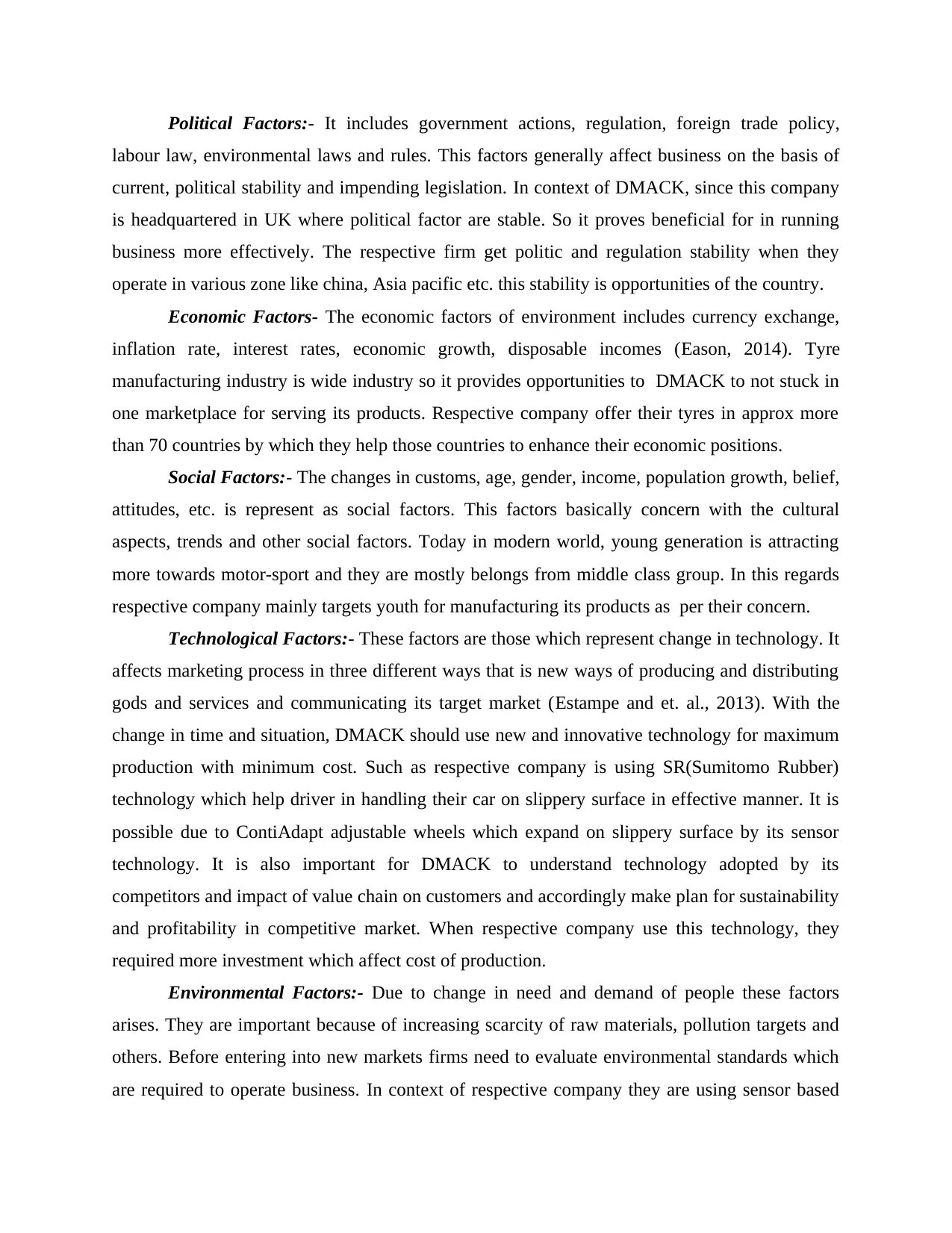
Political Factors:- It includes government actions, regulation, foreign trade policy,
labour law, environmental laws and rules. This factors generally affect business on the basis of
current, political stability and impending legislation. In context of DMACK, since this company
is headquartered in UK where political factor are stable. So it proves beneficial for in running
business more effectively. The respective firm get politic and regulation stability when they
operate in various zone like china, Asia pacific etc. this stability is opportunities of the country.
Economic Factors- The economic factors of environment includes currency exchange,
inflation rate, interest rates, economic growth, disposable incomes (Eason, 2014). Tyre
manufacturing industry is wide industry so it provides opportunities to DMACK to not stuck in
one marketplace for serving its products. Respective company offer their tyres in approx more
than 70 countries by which they help those countries to enhance their economic positions.
Social Factors:- The changes in customs, age, gender, income, population growth, belief,
attitudes, etc. is represent as social factors. This factors basically concern with the cultural
aspects, trends and other social factors. Today in modern world, young generation is attracting
more towards motor-sport and they are mostly belongs from middle class group. In this regards
respective company mainly targets youth for manufacturing its products as per their concern.
Technological Factors:- These factors are those which represent change in technology. It
affects marketing process in three different ways that is new ways of producing and distributing
gods and services and communicating its target market (Estampe and et. al., 2013). With the
change in time and situation, DMACK should use new and innovative technology for maximum
production with minimum cost. Such as respective company is using SR(Sumitomo Rubber)
technology which help driver in handling their car on slippery surface in effective manner. It is
possible due to ContiAdapt adjustable wheels which expand on slippery surface by its sensor
technology. It is also important for DMACK to understand technology adopted by its
competitors and impact of value chain on customers and accordingly make plan for sustainability
and profitability in competitive market. When respective company use this technology, they
required more investment which affect cost of production.
Environmental Factors:- Due to change in need and demand of people these factors
arises. They are important because of increasing scarcity of raw materials, pollution targets and
others. Before entering into new markets firms need to evaluate environmental standards which
are required to operate business. In context of respective company they are using sensor based
labour law, environmental laws and rules. This factors generally affect business on the basis of
current, political stability and impending legislation. In context of DMACK, since this company
is headquartered in UK where political factor are stable. So it proves beneficial for in running
business more effectively. The respective firm get politic and regulation stability when they
operate in various zone like china, Asia pacific etc. this stability is opportunities of the country.
Economic Factors- The economic factors of environment includes currency exchange,
inflation rate, interest rates, economic growth, disposable incomes (Eason, 2014). Tyre
manufacturing industry is wide industry so it provides opportunities to DMACK to not stuck in
one marketplace for serving its products. Respective company offer their tyres in approx more
than 70 countries by which they help those countries to enhance their economic positions.
Social Factors:- The changes in customs, age, gender, income, population growth, belief,
attitudes, etc. is represent as social factors. This factors basically concern with the cultural
aspects, trends and other social factors. Today in modern world, young generation is attracting
more towards motor-sport and they are mostly belongs from middle class group. In this regards
respective company mainly targets youth for manufacturing its products as per their concern.
Technological Factors:- These factors are those which represent change in technology. It
affects marketing process in three different ways that is new ways of producing and distributing
gods and services and communicating its target market (Estampe and et. al., 2013). With the
change in time and situation, DMACK should use new and innovative technology for maximum
production with minimum cost. Such as respective company is using SR(Sumitomo Rubber)
technology which help driver in handling their car on slippery surface in effective manner. It is
possible due to ContiAdapt adjustable wheels which expand on slippery surface by its sensor
technology. It is also important for DMACK to understand technology adopted by its
competitors and impact of value chain on customers and accordingly make plan for sustainability
and profitability in competitive market. When respective company use this technology, they
required more investment which affect cost of production.
Environmental Factors:- Due to change in need and demand of people these factors
arises. They are important because of increasing scarcity of raw materials, pollution targets and
others. Before entering into new markets firms need to evaluate environmental standards which
are required to operate business. In context of respective company they are using sensor based
Paraphrase This Document
Need a fresh take? Get an instant paraphrase of this document with our AI Paraphraser
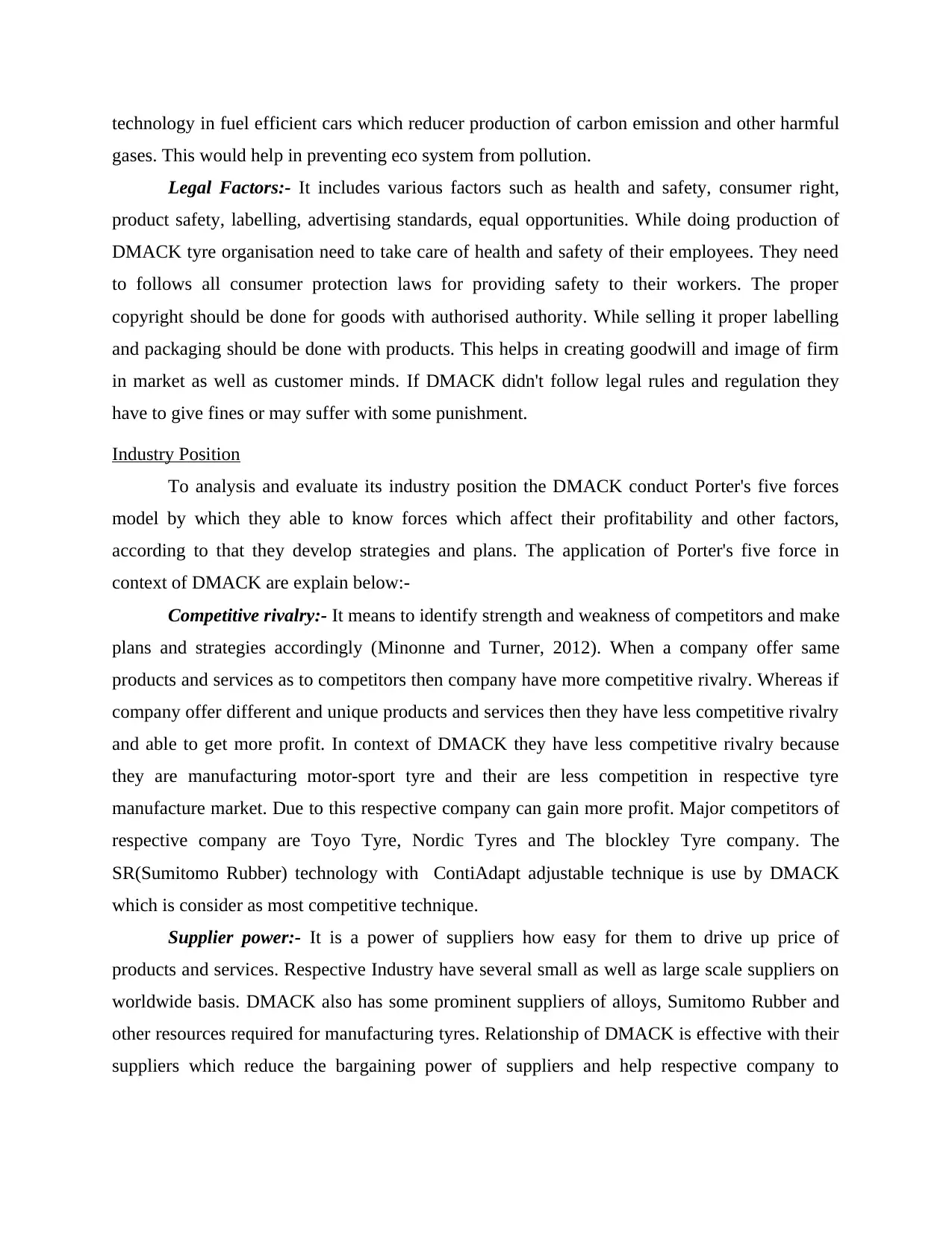
technology in fuel efficient cars which reducer production of carbon emission and other harmful
gases. This would help in preventing eco system from pollution.
Legal Factors:- It includes various factors such as health and safety, consumer right,
product safety, labelling, advertising standards, equal opportunities. While doing production of
DMACK tyre organisation need to take care of health and safety of their employees. They need
to follows all consumer protection laws for providing safety to their workers. The proper
copyright should be done for goods with authorised authority. While selling it proper labelling
and packaging should be done with products. This helps in creating goodwill and image of firm
in market as well as customer minds. If DMACK didn't follow legal rules and regulation they
have to give fines or may suffer with some punishment.
Industry Position
To analysis and evaluate its industry position the DMACK conduct Porter's five forces
model by which they able to know forces which affect their profitability and other factors,
according to that they develop strategies and plans. The application of Porter's five force in
context of DMACK are explain below:-
Competitive rivalry:- It means to identify strength and weakness of competitors and make
plans and strategies accordingly (Minonne and Turner, 2012). When a company offer same
products and services as to competitors then company have more competitive rivalry. Whereas if
company offer different and unique products and services then they have less competitive rivalry
and able to get more profit. In context of DMACK they have less competitive rivalry because
they are manufacturing motor-sport tyre and their are less competition in respective tyre
manufacture market. Due to this respective company can gain more profit. Major competitors of
respective company are Toyo Tyre, Nordic Tyres and The blockley Tyre company. The
SR(Sumitomo Rubber) technology with ContiAdapt adjustable technique is use by DMACK
which is consider as most competitive technique.
Supplier power:- It is a power of suppliers how easy for them to drive up price of
products and services. Respective Industry have several small as well as large scale suppliers on
worldwide basis. DMACK also has some prominent suppliers of alloys, Sumitomo Rubber and
other resources required for manufacturing tyres. Relationship of DMACK is effective with their
suppliers which reduce the bargaining power of suppliers and help respective company to
gases. This would help in preventing eco system from pollution.
Legal Factors:- It includes various factors such as health and safety, consumer right,
product safety, labelling, advertising standards, equal opportunities. While doing production of
DMACK tyre organisation need to take care of health and safety of their employees. They need
to follows all consumer protection laws for providing safety to their workers. The proper
copyright should be done for goods with authorised authority. While selling it proper labelling
and packaging should be done with products. This helps in creating goodwill and image of firm
in market as well as customer minds. If DMACK didn't follow legal rules and regulation they
have to give fines or may suffer with some punishment.
Industry Position
To analysis and evaluate its industry position the DMACK conduct Porter's five forces
model by which they able to know forces which affect their profitability and other factors,
according to that they develop strategies and plans. The application of Porter's five force in
context of DMACK are explain below:-
Competitive rivalry:- It means to identify strength and weakness of competitors and make
plans and strategies accordingly (Minonne and Turner, 2012). When a company offer same
products and services as to competitors then company have more competitive rivalry. Whereas if
company offer different and unique products and services then they have less competitive rivalry
and able to get more profit. In context of DMACK they have less competitive rivalry because
they are manufacturing motor-sport tyre and their are less competition in respective tyre
manufacture market. Due to this respective company can gain more profit. Major competitors of
respective company are Toyo Tyre, Nordic Tyres and The blockley Tyre company. The
SR(Sumitomo Rubber) technology with ContiAdapt adjustable technique is use by DMACK
which is consider as most competitive technique.
Supplier power:- It is a power of suppliers how easy for them to drive up price of
products and services. Respective Industry have several small as well as large scale suppliers on
worldwide basis. DMACK also has some prominent suppliers of alloys, Sumitomo Rubber and
other resources required for manufacturing tyres. Relationship of DMACK is effective with their
suppliers which reduce the bargaining power of suppliers and help respective company to
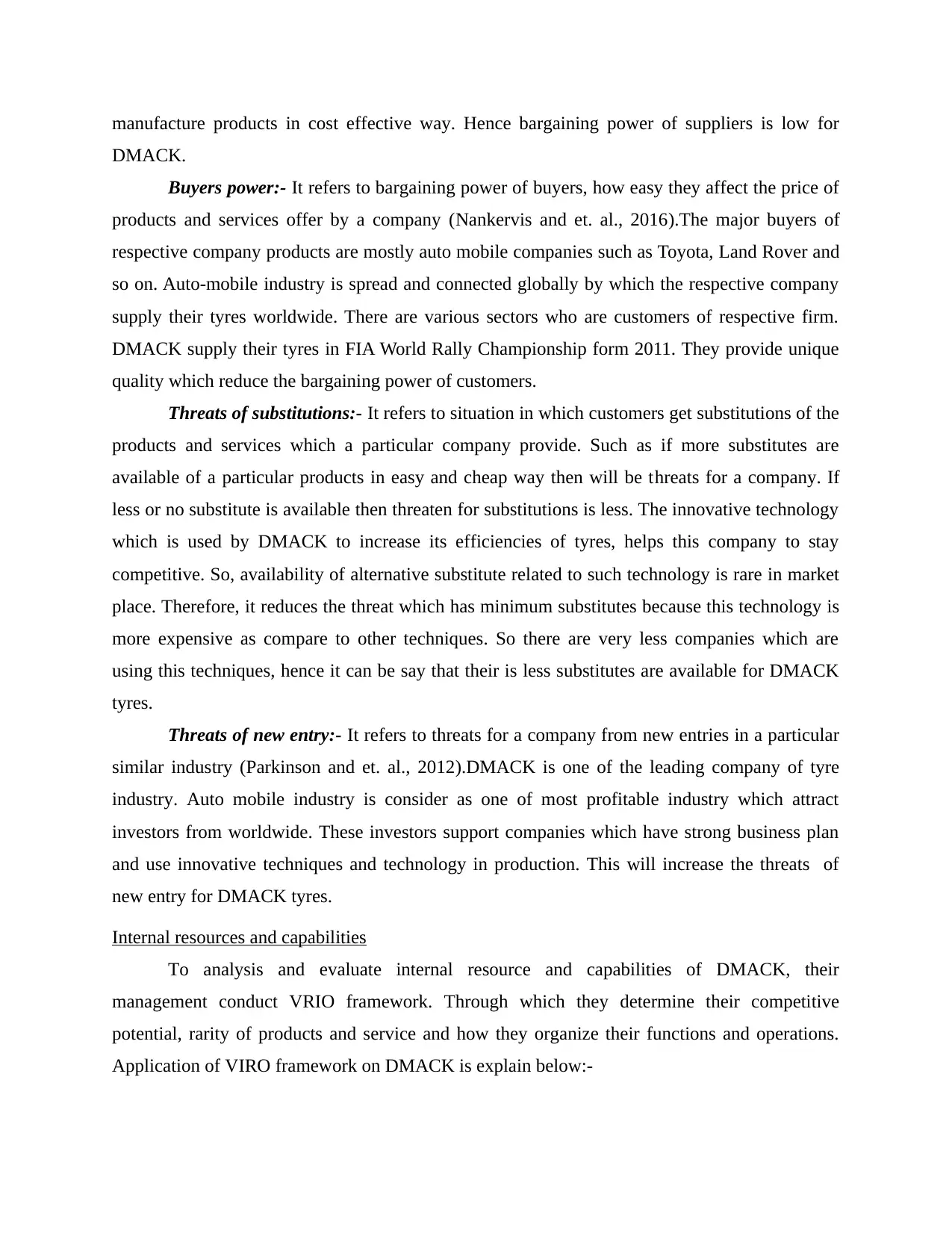
manufacture products in cost effective way. Hence bargaining power of suppliers is low for
DMACK.
Buyers power:- It refers to bargaining power of buyers, how easy they affect the price of
products and services offer by a company (Nankervis and et. al., 2016).The major buyers of
respective company products are mostly auto mobile companies such as Toyota, Land Rover and
so on. Auto-mobile industry is spread and connected globally by which the respective company
supply their tyres worldwide. There are various sectors who are customers of respective firm.
DMACK supply their tyres in FIA World Rally Championship form 2011. They provide unique
quality which reduce the bargaining power of customers.
Threats of substitutions:- It refers to situation in which customers get substitutions of the
products and services which a particular company provide. Such as if more substitutes are
available of a particular products in easy and cheap way then will be threats for a company. If
less or no substitute is available then threaten for substitutions is less. The innovative technology
which is used by DMACK to increase its efficiencies of tyres, helps this company to stay
competitive. So, availability of alternative substitute related to such technology is rare in market
place. Therefore, it reduces the threat which has minimum substitutes because this technology is
more expensive as compare to other techniques. So there are very less companies which are
using this techniques, hence it can be say that their is less substitutes are available for DMACK
tyres.
Threats of new entry:- It refers to threats for a company from new entries in a particular
similar industry (Parkinson and et. al., 2012).DMACK is one of the leading company of tyre
industry. Auto mobile industry is consider as one of most profitable industry which attract
investors from worldwide. These investors support companies which have strong business plan
and use innovative techniques and technology in production. This will increase the threats of
new entry for DMACK tyres.
Internal resources and capabilities
To analysis and evaluate internal resource and capabilities of DMACK, their
management conduct VRIO framework. Through which they determine their competitive
potential, rarity of products and service and how they organize their functions and operations.
Application of VIRO framework on DMACK is explain below:-
DMACK.
Buyers power:- It refers to bargaining power of buyers, how easy they affect the price of
products and services offer by a company (Nankervis and et. al., 2016).The major buyers of
respective company products are mostly auto mobile companies such as Toyota, Land Rover and
so on. Auto-mobile industry is spread and connected globally by which the respective company
supply their tyres worldwide. There are various sectors who are customers of respective firm.
DMACK supply their tyres in FIA World Rally Championship form 2011. They provide unique
quality which reduce the bargaining power of customers.
Threats of substitutions:- It refers to situation in which customers get substitutions of the
products and services which a particular company provide. Such as if more substitutes are
available of a particular products in easy and cheap way then will be threats for a company. If
less or no substitute is available then threaten for substitutions is less. The innovative technology
which is used by DMACK to increase its efficiencies of tyres, helps this company to stay
competitive. So, availability of alternative substitute related to such technology is rare in market
place. Therefore, it reduces the threat which has minimum substitutes because this technology is
more expensive as compare to other techniques. So there are very less companies which are
using this techniques, hence it can be say that their is less substitutes are available for DMACK
tyres.
Threats of new entry:- It refers to threats for a company from new entries in a particular
similar industry (Parkinson and et. al., 2012).DMACK is one of the leading company of tyre
industry. Auto mobile industry is consider as one of most profitable industry which attract
investors from worldwide. These investors support companies which have strong business plan
and use innovative techniques and technology in production. This will increase the threats of
new entry for DMACK tyres.
Internal resources and capabilities
To analysis and evaluate internal resource and capabilities of DMACK, their
management conduct VRIO framework. Through which they determine their competitive
potential, rarity of products and service and how they organize their functions and operations.
Application of VIRO framework on DMACK is explain below:-
⊘ This is a preview!⊘
Do you want full access?
Subscribe today to unlock all pages.

Trusted by 1+ million students worldwide
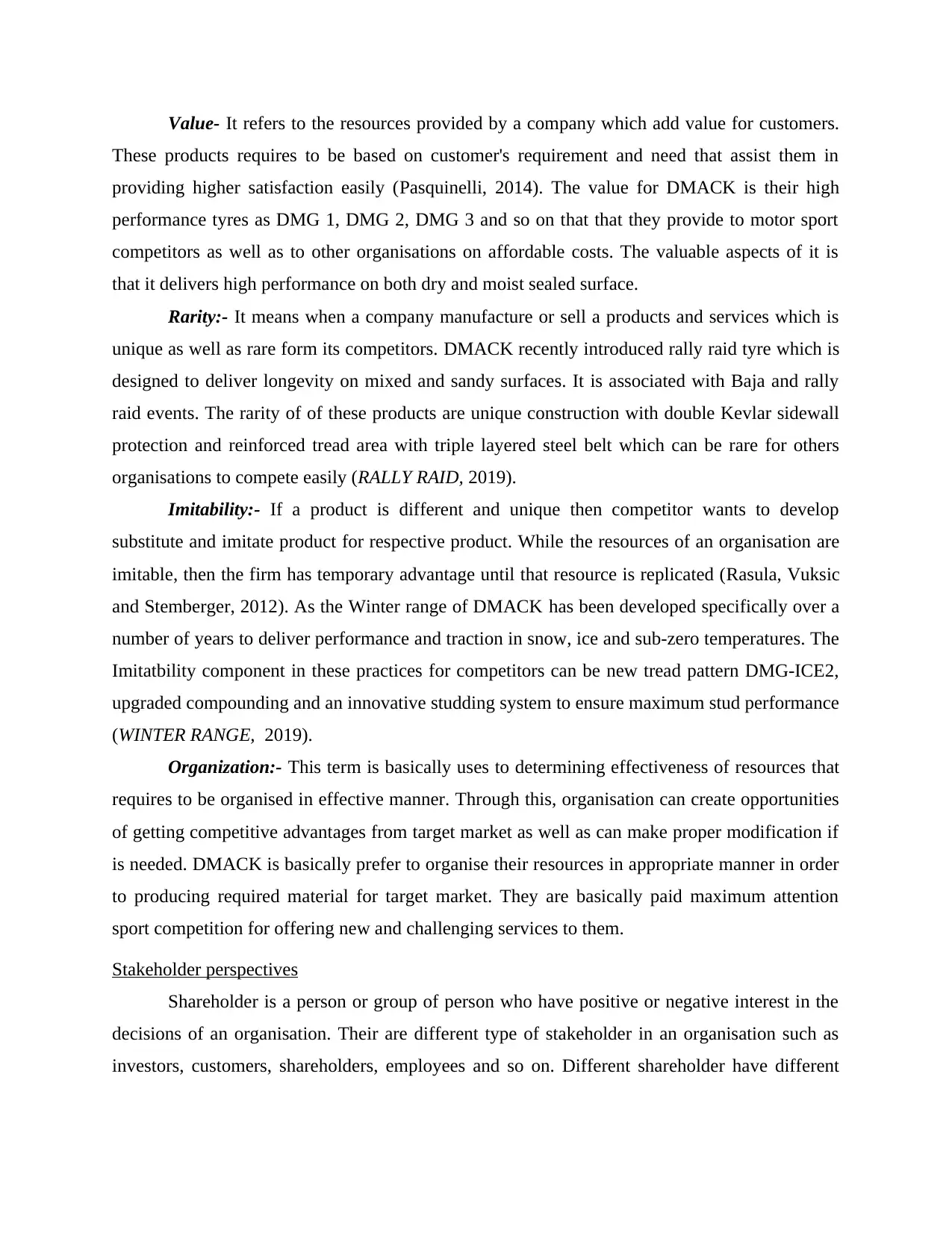
Value- It refers to the resources provided by a company which add value for customers.
These products requires to be based on customer's requirement and need that assist them in
providing higher satisfaction easily (Pasquinelli, 2014). The value for DMACK is their high
performance tyres as DMG 1, DMG 2, DMG 3 and so on that that they provide to motor sport
competitors as well as to other organisations on affordable costs. The valuable aspects of it is
that it delivers high performance on both dry and moist sealed surface.
Rarity:- It means when a company manufacture or sell a products and services which is
unique as well as rare form its competitors. DMACK recently introduced rally raid tyre which is
designed to deliver longevity on mixed and sandy surfaces. It is associated with Baja and rally
raid events. The rarity of of these products are unique construction with double Kevlar sidewall
protection and reinforced tread area with triple layered steel belt which can be rare for others
organisations to compete easily (RALLY RAID, 2019).
Imitability:- If a product is different and unique then competitor wants to develop
substitute and imitate product for respective product. While the resources of an organisation are
imitable, then the firm has temporary advantage until that resource is replicated (Rasula, Vuksic
and Stemberger, 2012). As the Winter range of DMACK has been developed specifically over a
number of years to deliver performance and traction in snow, ice and sub-zero temperatures. The
Imitatbility component in these practices for competitors can be new tread pattern DMG-ICE2,
upgraded compounding and an innovative studding system to ensure maximum stud performance
(WINTER RANGE, 2019).
Organization:- This term is basically uses to determining effectiveness of resources that
requires to be organised in effective manner. Through this, organisation can create opportunities
of getting competitive advantages from target market as well as can make proper modification if
is needed. DMACK is basically prefer to organise their resources in appropriate manner in order
to producing required material for target market. They are basically paid maximum attention
sport competition for offering new and challenging services to them.
Stakeholder perspectives
Shareholder is a person or group of person who have positive or negative interest in the
decisions of an organisation. Their are different type of stakeholder in an organisation such as
investors, customers, shareholders, employees and so on. Different shareholder have different
These products requires to be based on customer's requirement and need that assist them in
providing higher satisfaction easily (Pasquinelli, 2014). The value for DMACK is their high
performance tyres as DMG 1, DMG 2, DMG 3 and so on that that they provide to motor sport
competitors as well as to other organisations on affordable costs. The valuable aspects of it is
that it delivers high performance on both dry and moist sealed surface.
Rarity:- It means when a company manufacture or sell a products and services which is
unique as well as rare form its competitors. DMACK recently introduced rally raid tyre which is
designed to deliver longevity on mixed and sandy surfaces. It is associated with Baja and rally
raid events. The rarity of of these products are unique construction with double Kevlar sidewall
protection and reinforced tread area with triple layered steel belt which can be rare for others
organisations to compete easily (RALLY RAID, 2019).
Imitability:- If a product is different and unique then competitor wants to develop
substitute and imitate product for respective product. While the resources of an organisation are
imitable, then the firm has temporary advantage until that resource is replicated (Rasula, Vuksic
and Stemberger, 2012). As the Winter range of DMACK has been developed specifically over a
number of years to deliver performance and traction in snow, ice and sub-zero temperatures. The
Imitatbility component in these practices for competitors can be new tread pattern DMG-ICE2,
upgraded compounding and an innovative studding system to ensure maximum stud performance
(WINTER RANGE, 2019).
Organization:- This term is basically uses to determining effectiveness of resources that
requires to be organised in effective manner. Through this, organisation can create opportunities
of getting competitive advantages from target market as well as can make proper modification if
is needed. DMACK is basically prefer to organise their resources in appropriate manner in order
to producing required material for target market. They are basically paid maximum attention
sport competition for offering new and challenging services to them.
Stakeholder perspectives
Shareholder is a person or group of person who have positive or negative interest in the
decisions of an organisation. Their are different type of stakeholder in an organisation such as
investors, customers, shareholders, employees and so on. Different shareholder have different
Paraphrase This Document
Need a fresh take? Get an instant paraphrase of this document with our AI Paraphraser
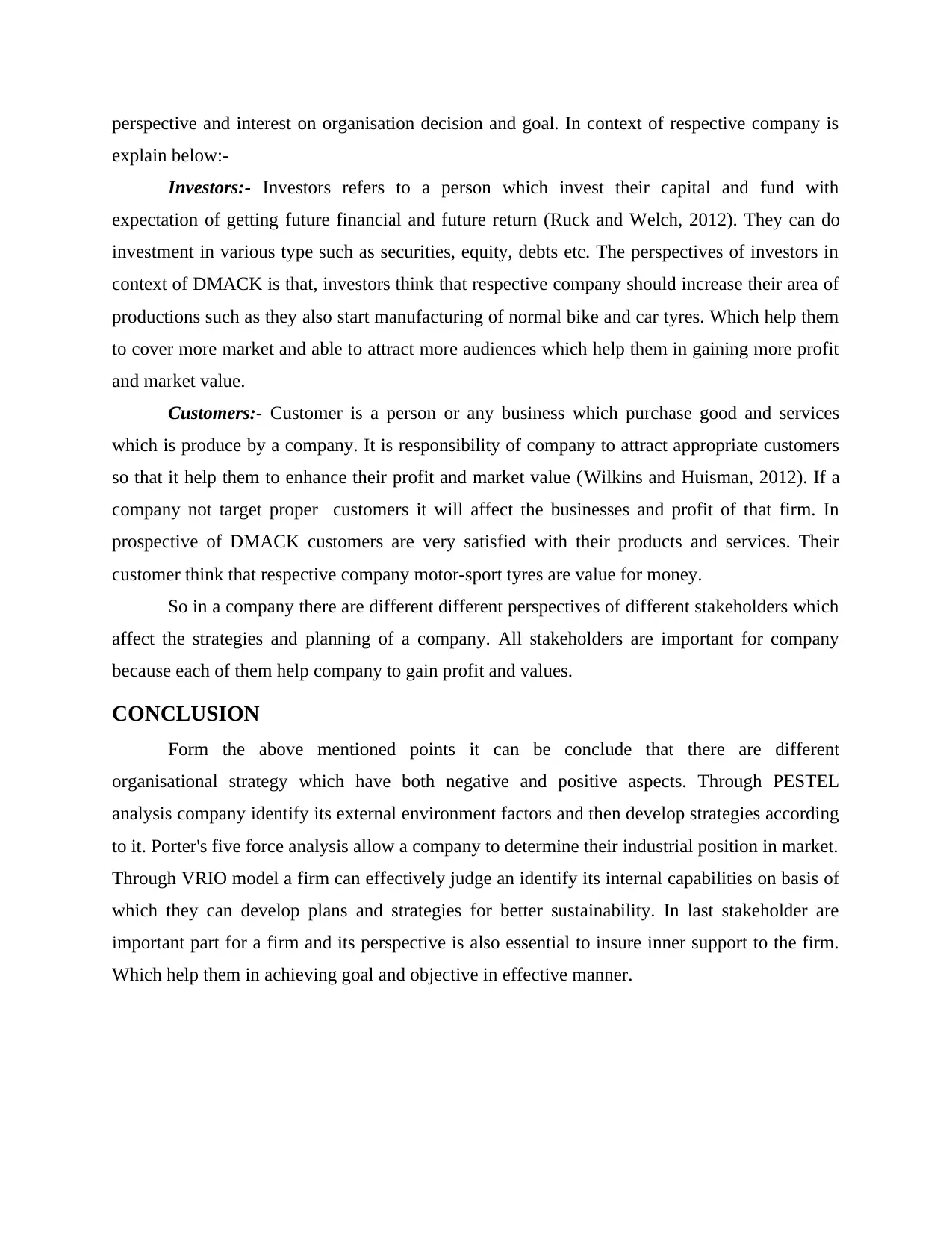
perspective and interest on organisation decision and goal. In context of respective company is
explain below:-
Investors:- Investors refers to a person which invest their capital and fund with
expectation of getting future financial and future return (Ruck and Welch, 2012). They can do
investment in various type such as securities, equity, debts etc. The perspectives of investors in
context of DMACK is that, investors think that respective company should increase their area of
productions such as they also start manufacturing of normal bike and car tyres. Which help them
to cover more market and able to attract more audiences which help them in gaining more profit
and market value.
Customers:- Customer is a person or any business which purchase good and services
which is produce by a company. It is responsibility of company to attract appropriate customers
so that it help them to enhance their profit and market value (Wilkins and Huisman, 2012). If a
company not target proper customers it will affect the businesses and profit of that firm. In
prospective of DMACK customers are very satisfied with their products and services. Their
customer think that respective company motor-sport tyres are value for money.
So in a company there are different different perspectives of different stakeholders which
affect the strategies and planning of a company. All stakeholders are important for company
because each of them help company to gain profit and values.
CONCLUSION
Form the above mentioned points it can be conclude that there are different
organisational strategy which have both negative and positive aspects. Through PESTEL
analysis company identify its external environment factors and then develop strategies according
to it. Porter's five force analysis allow a company to determine their industrial position in market.
Through VRIO model a firm can effectively judge an identify its internal capabilities on basis of
which they can develop plans and strategies for better sustainability. In last stakeholder are
important part for a firm and its perspective is also essential to insure inner support to the firm.
Which help them in achieving goal and objective in effective manner.
explain below:-
Investors:- Investors refers to a person which invest their capital and fund with
expectation of getting future financial and future return (Ruck and Welch, 2012). They can do
investment in various type such as securities, equity, debts etc. The perspectives of investors in
context of DMACK is that, investors think that respective company should increase their area of
productions such as they also start manufacturing of normal bike and car tyres. Which help them
to cover more market and able to attract more audiences which help them in gaining more profit
and market value.
Customers:- Customer is a person or any business which purchase good and services
which is produce by a company. It is responsibility of company to attract appropriate customers
so that it help them to enhance their profit and market value (Wilkins and Huisman, 2012). If a
company not target proper customers it will affect the businesses and profit of that firm. In
prospective of DMACK customers are very satisfied with their products and services. Their
customer think that respective company motor-sport tyres are value for money.
So in a company there are different different perspectives of different stakeholders which
affect the strategies and planning of a company. All stakeholders are important for company
because each of them help company to gain profit and values.
CONCLUSION
Form the above mentioned points it can be conclude that there are different
organisational strategy which have both negative and positive aspects. Through PESTEL
analysis company identify its external environment factors and then develop strategies according
to it. Porter's five force analysis allow a company to determine their industrial position in market.
Through VRIO model a firm can effectively judge an identify its internal capabilities on basis of
which they can develop plans and strategies for better sustainability. In last stakeholder are
important part for a firm and its perspective is also essential to insure inner support to the firm.
Which help them in achieving goal and objective in effective manner.
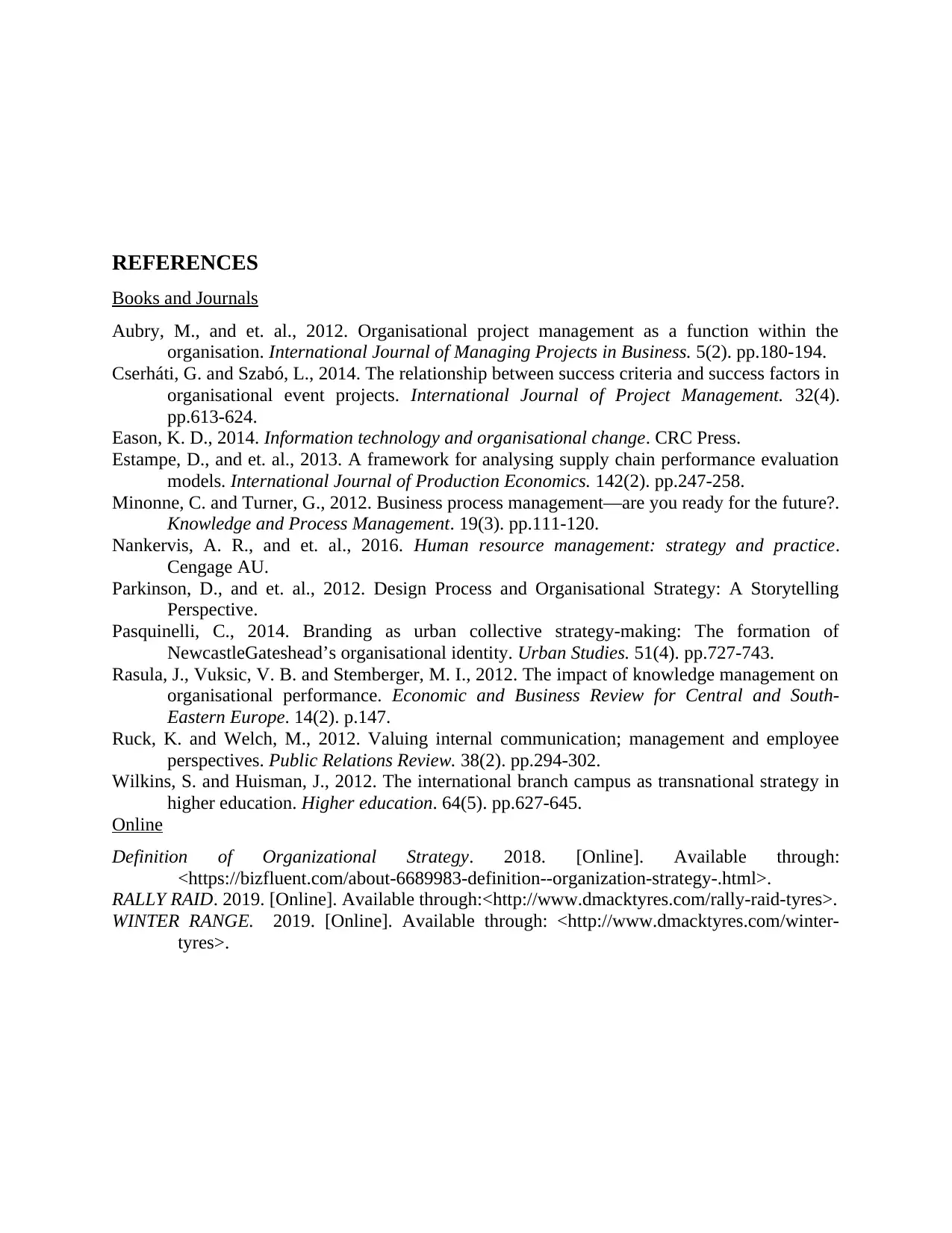
REFERENCES
Books and Journals
Aubry, M., and et. al., 2012. Organisational project management as a function within the
organisation. International Journal of Managing Projects in Business. 5(2). pp.180-194.
Cserháti, G. and Szabó, L., 2014. The relationship between success criteria and success factors in
organisational event projects. International Journal of Project Management. 32(4).
pp.613-624.
Eason, K. D., 2014. Information technology and organisational change. CRC Press.
Estampe, D., and et. al., 2013. A framework for analysing supply chain performance evaluation
models. International Journal of Production Economics. 142(2). pp.247-258.
Minonne, C. and Turner, G., 2012. Business process management—are you ready for the future?.
Knowledge and Process Management. 19(3). pp.111-120.
Nankervis, A. R., and et. al., 2016. Human resource management: strategy and practice.
Cengage AU.
Parkinson, D., and et. al., 2012. Design Process and Organisational Strategy: A Storytelling
Perspective.
Pasquinelli, C., 2014. Branding as urban collective strategy-making: The formation of
NewcastleGateshead’s organisational identity. Urban Studies. 51(4). pp.727-743.
Rasula, J., Vuksic, V. B. and Stemberger, M. I., 2012. The impact of knowledge management on
organisational performance. Economic and Business Review for Central and South-
Eastern Europe. 14(2). p.147.
Ruck, K. and Welch, M., 2012. Valuing internal communication; management and employee
perspectives. Public Relations Review. 38(2). pp.294-302.
Wilkins, S. and Huisman, J., 2012. The international branch campus as transnational strategy in
higher education. Higher education. 64(5). pp.627-645.
Online
Definition of Organizational Strategy. 2018. [Online]. Available through:
<https://bizfluent.com/about-6689983-definition--organization-strategy-.html>.
RALLY RAID. 2019. [Online]. Available through:<http://www.dmacktyres.com/rally-raid-tyres>.
WINTER RANGE. 2019. [Online]. Available through: <http://www.dmacktyres.com/winter-
tyres>.
Books and Journals
Aubry, M., and et. al., 2012. Organisational project management as a function within the
organisation. International Journal of Managing Projects in Business. 5(2). pp.180-194.
Cserháti, G. and Szabó, L., 2014. The relationship between success criteria and success factors in
organisational event projects. International Journal of Project Management. 32(4).
pp.613-624.
Eason, K. D., 2014. Information technology and organisational change. CRC Press.
Estampe, D., and et. al., 2013. A framework for analysing supply chain performance evaluation
models. International Journal of Production Economics. 142(2). pp.247-258.
Minonne, C. and Turner, G., 2012. Business process management—are you ready for the future?.
Knowledge and Process Management. 19(3). pp.111-120.
Nankervis, A. R., and et. al., 2016. Human resource management: strategy and practice.
Cengage AU.
Parkinson, D., and et. al., 2012. Design Process and Organisational Strategy: A Storytelling
Perspective.
Pasquinelli, C., 2014. Branding as urban collective strategy-making: The formation of
NewcastleGateshead’s organisational identity. Urban Studies. 51(4). pp.727-743.
Rasula, J., Vuksic, V. B. and Stemberger, M. I., 2012. The impact of knowledge management on
organisational performance. Economic and Business Review for Central and South-
Eastern Europe. 14(2). p.147.
Ruck, K. and Welch, M., 2012. Valuing internal communication; management and employee
perspectives. Public Relations Review. 38(2). pp.294-302.
Wilkins, S. and Huisman, J., 2012. The international branch campus as transnational strategy in
higher education. Higher education. 64(5). pp.627-645.
Online
Definition of Organizational Strategy. 2018. [Online]. Available through:
<https://bizfluent.com/about-6689983-definition--organization-strategy-.html>.
RALLY RAID. 2019. [Online]. Available through:<http://www.dmacktyres.com/rally-raid-tyres>.
WINTER RANGE. 2019. [Online]. Available through: <http://www.dmacktyres.com/winter-
tyres>.
⊘ This is a preview!⊘
Do you want full access?
Subscribe today to unlock all pages.

Trusted by 1+ million students worldwide
1 out of 9
Related Documents
Your All-in-One AI-Powered Toolkit for Academic Success.
+13062052269
info@desklib.com
Available 24*7 on WhatsApp / Email
![[object Object]](/_next/static/media/star-bottom.7253800d.svg)
Unlock your academic potential
Copyright © 2020–2025 A2Z Services. All Rights Reserved. Developed and managed by ZUCOL.





